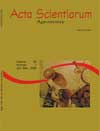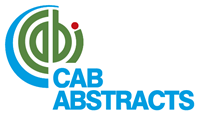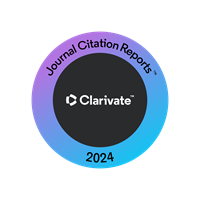<b>Production and chemical composition of alfalfa (<em>Medicago sativa</em> L. cv Crioula) in function of the soil rate humidity</b> - DOI: 10.4025/actasciagron.v25i1.2674
Abstract
The study was carried out from March 1997 to April 1998 aiming to evaluate the effect of water levels irrigation in the yield, in the distribution and chemical composition of alfalfa in field tests. The experimental design was totally randomized with four treatments: non-irrigated (T0), irrigated at 50%, 75% and 100% of the field capacity, considering 5 replications. In respect of the dry matter production, there was a significant difference (p < 0.05) between the water levels, irrigated and non-irrigated, and 100% of the field capacity. And there was also the effect of the year season (p < 0.05) with the summer yield being higher than the winter yield. The cuttings in different seasons of the year did not affect (p < 0.05) the crude protein (CP), the neutral detergent fiber (NDF) and the acid detergent fiber (ADF). Nevertheless, the irrigated alfalfa showed higher CP content (p < 0.05) and lesser NDF and ADF, throughout the year. The maximum forage yield and quality of alfalfa cv. Crioula was only possible using the irrigation in field capacity with irregular distribution during the year, in spite of the fact that irrigation elevates the forage production and improves the chemical composition in both seasons.Downloads
Download data is not yet available.
Published
2008-04-23
How to Cite
Costa, C., Vieira, M. P., Venégas, F., Saad, J. C. C., & Cruz, R. L. (2008). <b>Production and chemical composition of alfalfa (<em>Medicago sativa</em> L. cv Crioula) in function of the soil rate humidity</b> - DOI: 10.4025/actasciagron.v25i1.2674. Acta Scientiarum. Agronomy, 25(1), 215-222. https://doi.org/10.4025/actasciagron.v25i1.2674
Issue
Section
Agronomy
DECLARATION OF ORIGINALITY AND COPYRIGHTS
I Declare that current article is original and has not been submitted for publication, in part or in whole, to any other national or international journal.
The copyrights belong exclusively to the authors. Published content is licensed under Creative Commons Attribution 4.0 (CC BY 4.0) guidelines, which allows sharing (copy and distribution of the material in any medium or format) and adaptation (remix, transform, and build upon the material) for any purpose, even commercially, under the terms of attribution.
2.0
2019CiteScore
60th percentile
Powered by 

2.0
2019CiteScore
60th percentile
Powered by 



















































